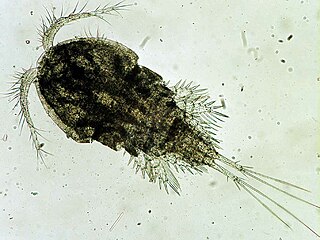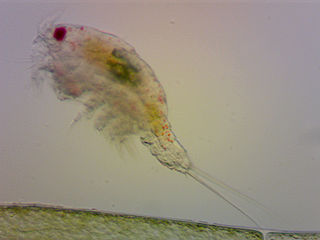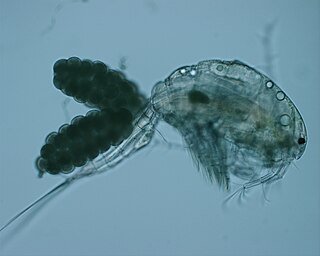
Cyclops is one of the most common genera of freshwater copepods, comprising over 400 species. Together with other similar-sized non-copepod fresh-water crustaceans, especially cladocera, they are commonly called water fleas. The name Cyclops comes from the Cyclops of Greek mythology, as they have a single large eye; in Cyclops, the eye may be either red or black.

Diaptomus is a genus of copepods with a single eye spot. It is superficially similar in size and appearance to Cyclops. However it has characteristically very long first antennae that exceed the body length. In addition, the females carry the eggs in a single sac rather than the twin sacs seen in Cyclops. It is a copepod of larger freshwater ponds, lakes and still waters.
Afrocyclops is a genus of copepod crustaceans in the family Cyclopidae, containing the following species:
Arctodiaptomus is a genus of copepods in the family Diaptomidae.
Argyrodiaptomus is a genus of copepods in the family Diaptomidae, containing the following species:

Attheyella is a genus of copepods in the family Canthocamptidae, containing the following species:
Boeckella is a genus of copepods in the family Centropagidae.
Elaphoidella is a genus of freshwater copepods in the family Canthocamptidae. It contains over 200 species, including three classified as vulnerable species by the IUCN – three endemic to Slovenia and one endemic to the United States. In total, the genus Elaphoidella contains the following species:

Eudiaptomus is a genus of freshwater crustaceans in the family Diaptomidae. It contains the following species:

Mesocyclops is a genus of copepod crustaceans in the family Cyclopidae. Because the various species of Mesocyclops are known to prey on mosquito larvae, it is used as a nontoxic and inexpensive form of biological mosquito control.
Paradiaptomus is a genus of crustacean in the family Diaptomidae. It includes the following species:
Phyllodiaptomus is a genus of crustacean in the family Diaptomidae. It includes the following species:

Thermocyclops is a genus of crustacean in family Cyclopidae. It was first described and later extensively researched by Friedrich Kiefer, who discovered some 20 species. The species and subspecies of the genus inhabit fresh and brackish waters alike all around the world, although most are from tropical areas.
Thermodiaptomus is a genus of copepods in the family Diaptomidae, containing the following species:
Tropodiaptomus is a genus of copepods in the family Diaptomidae. It includes the following species, many of which are narrow endemics and are included on the IUCN Red List :

Diaptomidae is a family of freshwater pelagic copepods. It includes around 50 genera:

The Cyclopidae are a family of copepods containing more than half of the 1,200 species in the order Cyclopoida in over 70 genera.
Centropagidae is a family of copepods. Its members are particularly known as plankton in coastal waters and in fresh water in Australia and southern South America. They are also found on subantarctic islands and in lakes in Antarctica.
Microcyclops is a genus of copepods, containing the following species:

Leptodiaptomus is a genus of copepods belonging to the family Diaptomidae.








